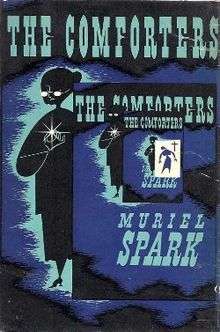The Comforters
 First edition | |
| Author | Muriel Spark |
|---|---|
| Country | United Kingdom |
| Language | English |
| Publisher |
Macmillan (UK) Lippincott (US) |
Publication date | February 1957 (UK) |
| Media type | |
| Pages | 232 |
| OCLC | 1238257 |
The Comforters is the first novel by Scottish author Muriel Spark. She drew on experiences as a recent convert to Catholicism and having suffered hallucinations due to using Dexedrine, an amphetamine then available over the counter for dieting. Although completed in late 1955, the book was not published until 1957. A mutual friend, novelist Alan Barnsley, had sent the proofs to Evelyn Waugh. At the time Waugh was writing The Ordeal of Gilbert Pinfold, which dealt with his own drug-induced hallucinations.
Waugh's and others positive responses prompted Macmillan to publish the novel in February 1957 in the United Kingdom, and it was also published that same year in the United States. The novel's quick success enabled Spark to give up editorial work and devote herself to full-time creative writing.[1][2] It has been published in several editions in the United Kingdom and the United States since then.
Plot: Introduction
The central character is Caroline Rose, a novelist recently converted to Catholicism. On returning from a retreat, she starts hearing voices and the sound of a typewriter. The words she hears seem to coincide exactly with her own thoughts. Meanwhile her boyfriend Laurence, who has been staying with his grandmother in Sussex, discovers the older woman is involved in smuggling.
Reception
A friend of Spark's sent her novel to Evelyn Waugh and Graham Greene, who both were positive. Their responses helped gain publication by Macmillan. Others also praised it. Waugh wrote, "The first half, up to the motor accident, is brilliant. The second half rather diffuse. The mechanics of the hallucinations are well managed. These particularly interested me as I am myself engaged on a similar subject [The Ordeal of Gilbert Pinfold]. Mrs Spark no doubt wants a phrase to quote on the wrapper and advertisements. She can report me as saying: 'brilliantly original and fascinating'."[2] Greene wrote, "One of the few really original first novels one has read for many years."[2]
Published in the United Kingdom (UK) in 1957, the novel quickly became a commercial success. It was published the same year in the United States (US). In 1963 and 1965, respectively, it was published in paperback in the two countries. New editions were published in 1978 in the UK and in 1984 in the US, as well as later in the century and in the 2000s.[3]
In 2009 Spark was described by the author Ali Smith as post-modern, speculating in this novel "about the act of making things, and people, up, about how and why we make narrative, and about the 'kind of truth' that emerges from fiction."[4]
Publication history
- 1957, UK, Macmillan, hardback
- 1957, US, Lippincott, hardback
- 1963, UK, Penguin, paperback
- 1965, US, Avon, paperback
- 1978, UK, Penguin, ISBN 0-14-001911-1, Pub date Apr 1978, paperback
- 1984, US, Perigree, ISBN 0-399-50931-3, Pub date Feb 1984, paperback
- 1994, US, New Directions, ISBN 0-811-21285-8, Pub date Sep 1994, paperback
- 2009, UK, Virago, ISBN 1-844-08553-8, Pub date 6 Aug 2009, paperback
- 2001, UK, ISIS, ISBN 0-753-18551-2, Pub date Apr 2011, Large Print (p/b)
References
- ↑ Eldrid Deleu, God versus the Author: Manipulation in Muriel Spark's The Comforters and Loitering with Intent, submitted August 2009, Ghent University
- 1 2 3 Martin Stannard, "A girl of slender means", The Guardian, 17 July 2009, accessed 11 January 2014
- 1 2 Muriel Spark, The Comforters, Fantastic Fiction website, Retrieved 2013-09-02
- ↑ Ali Smith, Review: "The typing ghost", The Guardian, 18 July 2009, accessed 11 January 2014